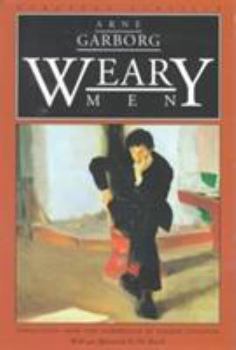Weary Men
With its angst-ridden, sensualist hero, Anne Garborg's classic, Weary Men , ( Trætte Mænd) invites comparison with the classic European decadent novels of the turn of the century--Huysmans's Against the Grain and Wilde's The Picture of Dorian Gray. Unlike the protagonists of those novels, however, the hero of Weary Men is treated with irony. And while it is a brilliant novel of ideas, Weary Men has endured primarily because of the acuity with which Garborg explores the roguish main character's psychological makeup. Originally published in 1891, Weary Men introduces a bachelor nearly middle age named Gabriel Gram, who suffers an existential crisis, considers suicide, but finally finds solace in a religious conversion of questionnable sincerity. Garborg depicts Gram's Kristiania (present day Oslo) in fascinating detail as Gram divides his time between male friends and "new women," a new generation of Norwegian women embolded to walk freely with men in public but who continue to rebuff Gram's sexual advances.
Format:Paperback
Language:English
ISBN:0810116006
ISBN13:9780810116009
Release Date:March 1999
Publisher:Northwestern University Press
Length:256 Pages
Weight:0.60 lbs.
Dimensions:0.7" x 5.2" x 7.7"
Customer Reviews
2 ratings
Perhaps Norway's best book in the fin-de-siècle decadent tradition
Published by Thriftbooks.com User , 18 years ago
The book brings us back to the circles we've seen before in Garborg's books, Oslo in the years before the end of the 19th century. The people are the same bohemian artists and bourgeois that we've mostly met before in previous books. The difference here is that it is much more personal than the previous books. It is written in the I-form, and is written like a diary or a series of impressions in scattered form. I found this book to be the best of his books that I've read so far, for several reasons. The book details a few years of Gabriel Gram's life, a weary man past his prime, hence the title. He's bound up by bourgeois conventions, but also tied to his bohemian lifestyle. He's in love with the heroine from the previous book in the series; Fanny Holmsen, but as we know, she marries an old man for his money, so Gabriel's heart is broken. He contemplates suicide, he tries alcohol, religion and philosophy, but nothing helps. I won't say much more about the book itself, I found it to be a fine representative of Norway's meagre contribution to the wider European fin-de-siècle literature, and unlike it's more decadent brothers, it actually tries to find solutions to the decline. Highly recommended as a picture of time past, and also as a mental diary of a struggling intellectual surrounded by the usual plebeians. (I read a different edition)
It's About Time
Published by Thriftbooks.com User , 25 years ago
Perhaps the most amazing thing about Sverre Lyngstad's translation of Trætte Mænd is that it hasn't been done earlier. After all, Garborg's novel of disillusion and decadence marks not only a unique chapter in his work, but a point of peculiarity in Norwegian literature as a whole. Beginning with Joris-Karl Huysman's novel A Rebours (Against Nature, 1884), Fin de siècle decadent literature flourished in Europe during the waning years of the 19th Century. Oscar Wilde and Herman Bang were merely two of a host of authors producing such highly aesthetic and anti-bourgeois texts. Yet in Norway the trend remained largely absent - with only a few exceptions, including Garborg's novel. Thus Weary Men is a novel of particular literary-historical significance, and Lyngstad's translation a welcome appearance.As to the translation itself, it is thoroughly adequate. While one occasionally wishes for a smoother turn of phrase (for example, "I alle tilfælde" is translated as "At all events" instead of the better-sounding "In any event"), the English rendition offers no significant stumbling blocks to the American reader. And the quality of translation improves significantly in the second half of the novel. It should also be mentioned that Lyngstad received the Inger Sjöberg Prize from the American-Scandinavian Foundation in 1996 for an excerpt of this translation.In addition to the actual text of the novel, Per Buvik's Afterward will be useful to students and teachers alike, particularly to those less familiar with the decadent movement in 19th Century European literature. Buvik places the novel in general European and Norwegian contexts, as well as in the context of Garborg's overall authorship. He also surveys some of the more prominent readings and criticisms of the text. All-in-all, this book is a success, and its publication is to be greeted warmly.






